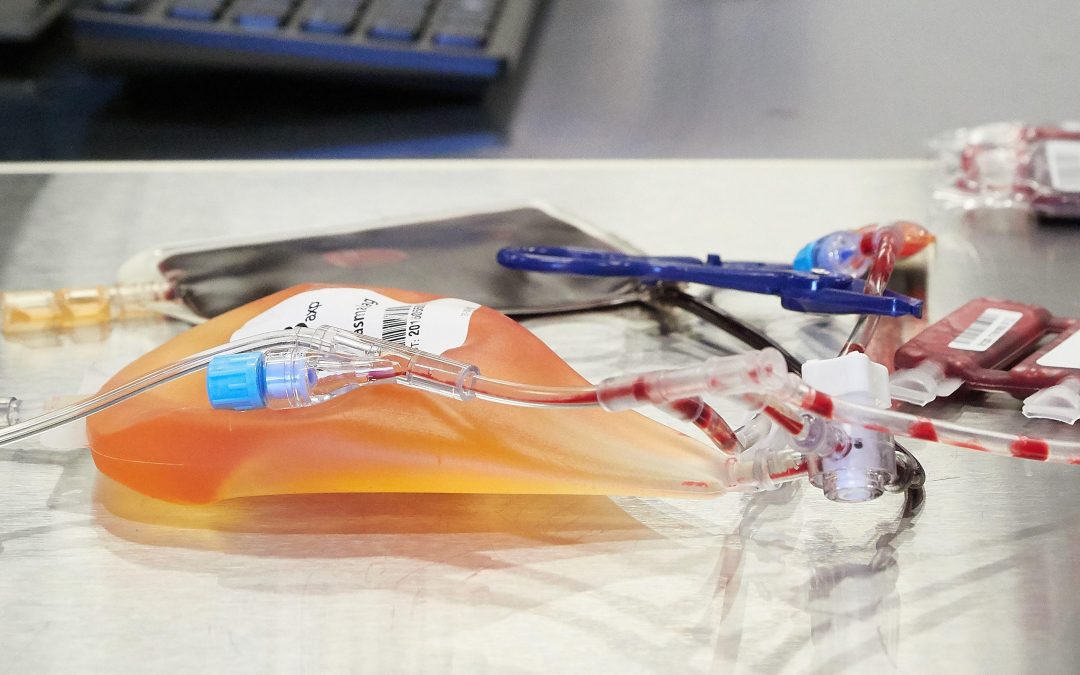By Tom Maguire | Associate editor
Sometimes, being a hero is effortless.
The Upstate Cord Blood Bank opened with a ceremony Feb. 9 at a new hilltop building in Syracuse. Central and Northern New York mothers who give birth are encouraged to donate the umbilical cord blood so its stem cells can be used to treat more than 80 diseases.
All it takes is a painless nod to life amid the glory of the birthing room. The priceless umbilical cord, which often was thrown out as medical waste, will supply stem cells for transplants and research in the treatment of cancers and other genetic diseases.
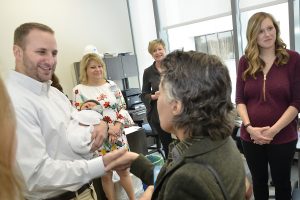
Upstate Medical University President Danielle Laraque-Arena meets Marc Moore and baby Jackson. Blood from Jackson’s umbilical cord was the first donation to the Upstate Cord Blood Bank. Are right is Jackson’s mom, Nicole Moore. (Photo courtesy Upstate Medical University)
A family from Auburn was the first to donate umbilical cord blood to the gleaming $15 million building that sits next to tall evergreen trees at the Upstate University Hospital Community Campus.
“It’s been a great week,” said the new dad, Marc Moore. His wife, Nicole, gave birth to their son, Jackson, Feb. 2. Jackson wore a little gray watch cap topped by a fuzzy ball as he rested quietly in his father’s arms at a news conference.
“We learned that it was a very risk-free, simple process that really didn’t involve much of our efforts at all,” Nicole said. “We were told that it’s able to help so many people, and we were able to still enjoy our son’s birth; we did not notice anything different in the backgrounds of the process. It was really a simple, pain-free experience that we hope will be able to help somebody in the future.”
She added: “We are proud that our first act as a family was being able to give back. So we hope that this encourages many other families to do the same.”
The new building is one of only two public cord blood banks in New York State, said Danielle Laraque-Arena, MD, FAAP, president of Upstate Medical University. There is no cost to donate. The cord blood that the Moores donated may be transplanted someday into a patient who needs it locally, nationally, or internationally. The identity of the donors is not revealed to the recipients.
According to information from Upstate University Hospital, “Cord blood stem cells are different than embryonic stem cells. Cord blood stem cells are taken from the umbilical cord and placenta and do not involve embryos.”
“It’s wonderful news,” Bishop Robert J. Cunningham said of the cord blood bank. “To have a cord blood bank right here in upstate New York is a gift of life for all people. I know it has been long in coming and I am grateful it is finally here.”
Lisa Hall, director of the diocesan Office of Family/Respect Life Ministry, said, “We are delighted to have this ethical alternative for lifesaving, life-affirming treatment. It’s wonderful.”
Dr. Laraque-Arena said the new blood bank is a reality due to the “energy and support” of state Sen. John A. DeFrancisco.
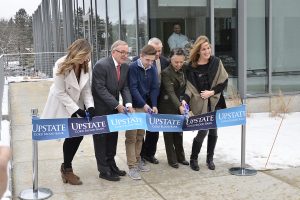
The ribbon at the Upstate Cord Blood Bank is cut by (from left) Nicole Moore, Sen. John DeFrancisco, Jared Saya, Nick Greco, PhD., Upstate President Danielle Laraque-Arena, MD, and Geralyn Saya. (Photo courtesy Upstate Medicla University)
“This is my 25th year in the Senate,” DeFrancisco said, “and I’ve done this [attended important events] hundreds of times. And I can state unequivocally that this is my proudest moment.
“This is an accomplishment that, really, at times I never thought was going to happen. But fortunately for the cooperation [and] expertise of so many people, it’s here today.
“And it’s a facility that’s going to ensure saving lives. So it was a l-o-o-o-ng journey, but it’s finally here.”
It is also a long journey for the stem cells themselves: extraction from the umbilical cord, the laboratory processes, and, finally, delivery to a hospital or research facility.
On ribbon-cutting day, wide-eyed media members dressed in gauzy white gowns toured the sterile processing lab and viewed the various colors and techniques involved in the separation of the blood’s components.
In one of the first stages, the visitors came upon two machines that looked like small scales. Fitting for an element that came from an infant, the flat tops of the machines rocked bags of blood back and forth in a mesmerizing rhythm. The black top part of the machines is textured so the bags don’t slide, said Patricia A. Pontello, a medical technologist who is the quality control supervisor in the lab. Air bubbles — some tiny, some that looked like amoebas — flopped around in the thick plastic bags, each shaped like a little doll house.
The playful-looking aspect belied a stunning science that continued with several other steps, including a count of white blood cells, application of a chemical to help the red blood cells settle out efficiently, sterility testing, and spinning of the blood in a refrigerated centrifuge.
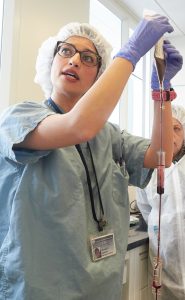
Jessica C. Giacona, a laboratory technologist at the Upstate Cord Blood Bank, demonstrates one of the processes involved in the harvesting of stem cells from donated umbilical cords. Cord blood can help generate new, healthy bone marrow. (Sun photo | Chuck Wainwright)
Laboratory technologist Jessica C. Giacona, another member of the staff who wears a blue coat during the processing, displayed containers that showed how the blood looks toward the end of the processing: A yellowish-red bag signified the blood plasma. A very dark bag contained red blood cells. And a tiny plastic case held the stem-cell-rich product. Emblematic of its status, this product looked a little bit brighter.
Those stem cells were destined to be held in shiny white drums about four feet high. These cryogenic storage containers can hold nearly 14,500 units of cord blood.
After the tour of the lab, DeFrancisco introduced the Saya family of Syracuse. Jared Saya, 19, was the recipient of a stem cell transplant from umbilical cord blood in 2002. A Christian Brothers Academy graduate, he is now a happy freshman studying business and finance and playing soccer at St. John Fisher College outside Rochester.
Jared’s mom, Geralyn, addressed the assemblage.
“Well, I could stand up here and tell you one of the many stories of his two bouts with cancer … but today we’re [here] to celebrate life,” she said.
She added: “Because of some woman who wanted to donate her cord blood, otherwise known as waste to her, my son is here today.”
Told that he looked happy, Jared said, “I am happy, I feel great.”
He thinks that a transplant like the one in Rochester that saved him is a “great idea and no reason why a pregnant woman should not donate. It can benefit anybody like it benefited me. And I don’t even know the woman, and I wish I could meet her.”
Jared’s father, Joseph, said the family pays a yearly fee for an out-of-state facility to store 15-year-old daughter Mari’s cord blood as a precaution for her.
The same option — cord blood that is owned by the family — is available at the Upstate Cord Blood Bank.
Regarding Jared’s healthy state, Joseph said, “We’re thankful that it’s been this long and we just take it every day, and of course it’s not completely on our minds every day now, as we move away from it, but there was a ton of anxiety as we were 2003, 2004, 5, 6, and 7, going in every quarter so they can draw blood and take a read and keep our fingers crossed that he was still in remission.”
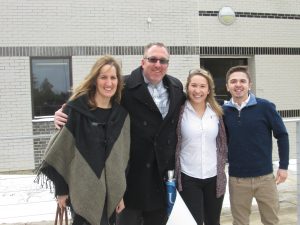
The Saya family celebrates the day. From left are Geralyn, Joseph, Mari, and Jared. Jared received a stem-cell transplant from umbilical cord blood in 2002. (Sun photo | Tom Maguire)
Joseph said Jared absolutely has the ability to follow in his footsteps as a financial adviser and real estate broker. “The business is there for him, but I want him to do whatever makes him happy,” Joseph said.
He’s just glad that Jared is healthy.
“That’s why we wanted him to go off to school and certainly experience that, because you don’t get that back,” he said. “And who knows? He’s heavy into soccer. He could be a sportscaster. He could be anything, like any kid.”

